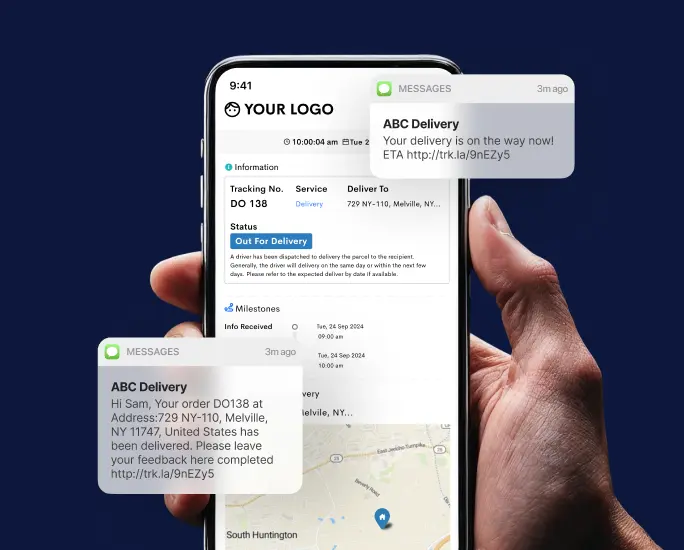Pharmaceutical deliveries are crucial in ensuring patients receive the necessary medications on time. Whether it’s life-saving drugs or routine prescriptions, the efficiency and reliability of pharmaceutical supply chains directly impact patient outcomes. However, managing pharmaceutical deliveries comes with unique challenges—temperature-sensitive products, strict regulatory requirements, and the necessity for timely delivery, making delivery management software handy.
Pharmaceutical companies must adopt advanced strategies to streamline their supply chains to keep up with growing demands and ensure smooth operations. In this blog, we’ll explore key strategies to optimize pharmaceutical deliveries, reduce risks, and improve overall efficiency.

Advanced Strategies for Pharmaceutical Deliveries
1. Real-Time Tracking for Transparency and Accountability
Real-time tracking is one of the most effective ways to streamline pharmaceutical deliveries. Pharmaceutical products often need to be handled with extreme care, and stakeholders—including manufacturers, distributors, and healthcare providers—need to know the exact location and condition of shipments at any given moment.
Implementing real-time tracking systems allows full visibility throughout the supply chain, ensuring that any issues, such as delays or temperature fluctuations, can be detected and addressed immediately. Advanced delivery management software, such as Detrack, enables companies to monitor the status of every delivery in real time, providing updates that ensure transparency and accountability.
Not only does real-time tracking enhance operational efficiency, but it also builds trust with customers. When healthcare providers or patients can track their deliveries in real time, they feel more confident in the reliability of the supply chain, which can enhance customer satisfaction.
2. Temperature Monitoring and Cold Chain Solutions
Pharmaceutical deliveries frequently involve transporting temperature-sensitive products, such as vaccines, biologics, and insulin. Maintaining these products within a strict temperature range, known as the cold chain, is essential to preserving their efficacy and safety.
Advanced temperature monitoring technology is essential to streamlining this aspect of the supply chain. Sensors and IoT-enabled devices can be integrated into delivery vehicles and containers to constantly monitor temperature conditions. If a shipment exceeds its designated temperature range, alerts can be triggered to allow immediate corrective actions.
Some pharmaceutical companies also invest in more innovative cold chain solutions, such as smart packaging that tracks temperature and location. This ensures product safety and enables more efficient delivery planning, as drivers can be alerted to take alternate routes if a cold chain breach is imminent.
3. Electronic Proof of Delivery (EPOD) for Streamlined Documentation
Electronic Proof of Delivery (EPOD) systems play a crucial role in enhancing the efficiency of pharmaceutical deliveries by ensuring accurate and secure documentation. Pharmaceutical deliveries often involve strict regulatory requirements that mandate precise tracking of each step in the delivery process.
With EPOD, drivers can digitally capture signatures, delivery confirmations, and other important data in real-time, eliminating the need for physical paperwork.This electronic approach helps reduce the risk of human error and ensures that delivery records are instantly accessible to stakeholders across the supply chain.
In the event of a regulatory audit, pharmaceutical companies can quickly retrieve all necessary documentation, demonstrating compliance with storage, handling, and transportation standards.

4. Adherence to Regulatory Requirements
Pharmaceutical supply chains are subject to various regulations to ensure patient safety and product efficacy. These include guidelines for product storage, handling, transportation, and detailed documentation of delivery processes.
Pharmaceutical companies need to adopt systems that automate regulatory documentation and track compliance in real-time to streamline operations while staying compliant. For example, electronic proof of delivery (EPOD) systems provide an efficient way to document deliveries and capture necessary signatures or records in digital formats. This not only reduces paperwork but also ensures that regulatory requirements are met.
Additionally, EPOD systems can be integrated with auditing tools that monitor compliance with local, national, and international regulations. This reduces the risk of fines or delays due to non-compliance, helping to keep the supply chain running smoothly.
5. Collaborative Supply Chain Management
Collaboration across the pharmaceutical supply chain is another critical strategy for improving efficiency. Manufacturers, distributors, logistics providers, and healthcare organizations must work together to ensure the seamless flow of products from production to delivery.
Supply chain collaboration tools allow stakeholders to share data, communicate in real time, and coordinate inventory management or delivery schedules. By breaking down silos and promoting transparency, pharmaceutical companies can respond to disruptions more quickly, adjust delivery plans in real time, and ensure that critical products reach their destination without unnecessary delays.
Moreover, collaboration tools enable better forecasting and demand planning, reducing the risk of overstocking or stockouts. With more accurate data, companies can optimize their inventory and delivery processes to keep costs down and maintain service quality.
6. Sustainability in Pharmaceutical Deliveries
The pharmaceutical industry is increasingly recognizing the importance of sustainability, including reducing its supply chain’s environmental impact. Streamlining pharmaceutical deliveries is not just about cost and time savings—it’s also about adopting greener practices.
Electric delivery vehicles, route optimization to reduce fuel consumption, and eco-friendly packaging solutions are all examples of sustainable strategies that can be applied in pharmaceutical supply chains. These initiatives not only reduce the carbon footprint of deliveries but also resonate with consumers who prioritize environmental responsibility.
Delivery management systems that track the environmental impact of each delivery can further support sustainability efforts, providing data to help companies optimize their green initiatives.
Conclusion
The pharmaceutical industry is evolving rapidly, and efficient delivery operations are key to meeting the growing demand for medications. By implementing advanced strategies like real-time tracking, automated dispatching, route optimization, and collaborative supply chain management, pharmaceutical companies can streamline their supply chains, reduce costs, and improve service quality.
In a world where patients’ lives depend on timely deliveries, these strategies are not just about improving efficiency—they’re about ensuring better health outcomes and building trust with customers worldwide.
Take your pharmaceutical deliveries to the next level with cutting-edge solutions. Book a demo today to see how Detrack can streamline your supply chain and ensure timely, reliable medication delivery.










